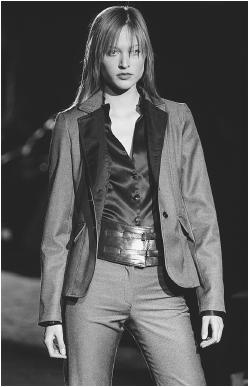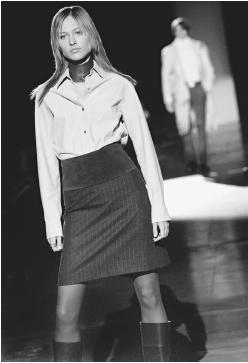Kenneth Cole - Fashion Designer Encyclopedia
American designer
Born: 23 March 1954 in Brooklyn, New York. Education: Emory University, 1976. Family: Married Maria Cuomo in 1987; three children. Career: President, CEO, and designer for Kenneth Cole

Publications
On COLE:
Articles
Critchell, Samantha, "Designer Combines Style, Activism," in Associated Press Online, 21 July 1999.
Gonzalez, Isabel, "In Style: For Kenneth Cole, Fashion, Activism AreDriving Forces," in Atlanta Journal and Constitution, 3 October 1999.
D'Innocenzio, Anne, "In the Zone," WWD, 22 March 2000.

Cunningham, Thomas, "Kenneth Cole: Firing on All Cylinders," WWD, 17 April 2000.
Sturrock, Staci, "Direct from Grand Central Casting: Kenneth Cole Mixes Politics and Pleasure With His Fresh Inaugural Collection," in Palm Beach Post, 21 September 2000.
Cole, Patrick, "Kenneth Cole Dives Into 'Shark Tank'," in Newsday, 31 October 2000.
*
I design products you can wear today and tomorrow from season to season. You want to look modern without being too edgy, and you always want value. I mean, you can buy a pair of shoes for a dollar, but if you never wear them you've paid too much.
—Kenneth Cole
***
To be aware is more important than what you wear.
—Kenneth Cole advertising tagline.
Kenneth Cole launched Kenneth Cole Productions with a trailer full of his women's shoe designs parked on Sixth Avenue during a 1982 shoe show. Eschewing the anonymity of being one among thousands in a room at the Hilton and unable to afford the grand midtown Manhattan showrooms preferred by the large companies, Cole changed his company's name from Kenneth Cole, Inc. to Kenneth Cole Productions, Inc. in order to obtain a film production permit (the only kind the city of New York would give) to park the truck. The name of the film listed on the permit was Birth of a Shoe Company. Within two and a half days, he and his crew sold 40,000 pairs of shoes. The Kenneth Cole name soon became synonymous with modishly hip urban footwear, followed by accessories. In 1998 Cole took on menswear, in which his collections quickly made a mark; he then debuted his first womenswear collection in a show at New York's Grand Central Station in 2000.
The term "hip-classic" has often been applied in describing Cole's designs. In both men's and women's collections, he utilizes a preponderance of leather and suede, along with silk shantung, cashmeres, wools, cottons, and synthetic fabric blends to create styles that manage to be both elegant and relaxed. Cole designs, in his own words, fashion for the "contemporary person who wants to have a sense of identity and personality, but also doesn't want to be the focal point of the crowd because of what he or she is wearing." His designs do not push the boundaries of comfort and wearability but court classic lines with imaginative twists and modern edges. In seeking a balancing point between fashionable élan and practical functionality, Cole's style blurs the lines between everyday casual and dresswear.
Cole's menswear collections have included everything from denims, quilted vests, and shirt jackets to narrow three-and four-button suits and techno-inspired outerwear in black with vivid linings. Black leather is generally in abundance for everything from streamlined coats to zippered vests to shirts worn under tailored pinstriped suits. Cole also uses a lot of metallic glazed or embossed leather. For women, collections range in these same areas, with a touch of whimsy in patchwork suedes in lime and tan, tie-dyed hot pants, hip-slung long pants, more metallics, and antiqued leathers. His colors tend toward the urban: black on black, navy, olive, gunmetal gray, bronze, though with his entry into womenswear the palette xpanded to include fresher and more vivid hues. His Fall 2001 collection, described as "his most sophisticated and luxe collection to date," joined menswear and womenswear into a harmonious whole on the runway.
A defining aspect of all of Cole's work has always been an active implementation of his social conscience through advertising campaigns, show themes, sales incentives, benefits, and a general dedication to consciousness-raising. His advertising campaigns typically feature taglines, such as "…sixty-two percent of society believes preferences other than their own are wrong. So much for seeing eye to eye," or "For every dollar a man makes, a woman earns seventy-six cents. Change please," and "The family gun stands a greater chance of killing you than a stranger." Cole writes much of this ad copy himself and grappling with such issues, he has stressed, is not just an advertising gimmick for the company but very much a part of its identity. Other examples of this commitment have been shows requiring attendees to donate a pair of shoes for the homeless, a traveling warehouse sale to benefit AIDS research, and sales incentives in the form of discounts in return for a donation of shoes or clothing. Preceding his shows have been films encouraging voting or talking about prejudice with, instead of the usual gifts found at fashions shows on attendees' seats, pamphlets or books underlining and informing on the issue in question.
As Cole says, "I'm trying to add value to the process of shopping. I'm trying to make what we do more relevant than it normally would be, because at the end of the day, I make shoes and pants, so sometimes it's hard to get totally motivated. You make what you do part of something bigger than it is. Then what you do becomes important and you can justify the compromises we all make." As well as being socially progressive, Cole is technologically forward, one of the first to engage in live webcasts of his runway shows. The live webcast of his Fall 2000 menswear show was designed to raise awareness about homelessness and benefit HELP USA.
Kenneth Cole Productions now oversees a retail empire spanning the U.S., with additional stores in Amsterdam, Hong Kong, Singapore, and Taiwan. Near the end of 2000, Cole opened an 18,000-square-foot flagship store on Fifth Avenue in New York at the entrance to Rockefeller Center. In addition to shoes, accessories, and men's and women's collections, the designer has ventured into jewelry, perfume, and a number of other licensing ventures. Future plans include expansion into children's clothing and home décor. It seems likely that both Cole's approach to style as a practical component of everyday life and his commitment to humanitarian causes will remain constant no matter how many areas of fashion and design he chooses to explore.
—JessicaReisman
Comment about this article, ask questions, or add new information about this topic: